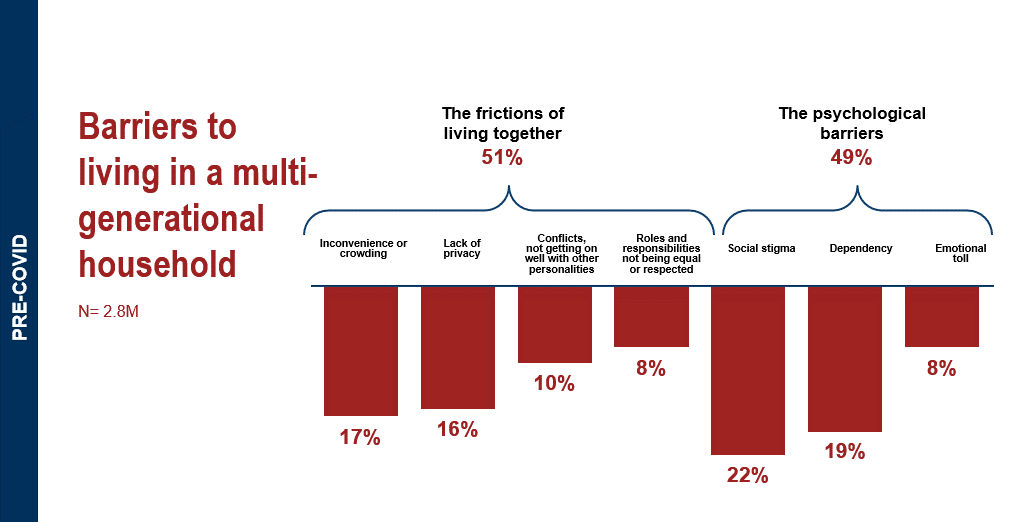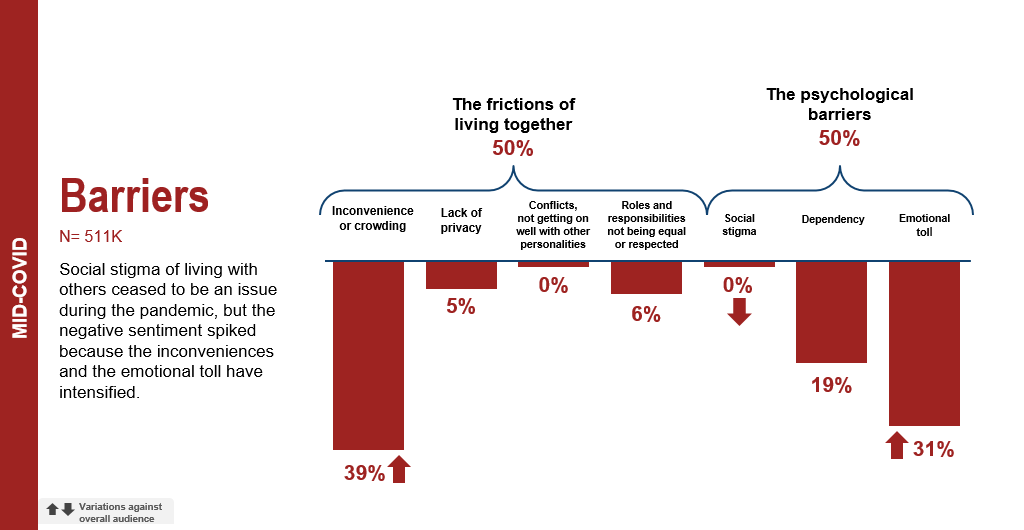Editor’s Note: This column is sponsored by the AARP Thought Leadership and International team. Thought Leadership and International seeks to position AARP as a global thought leader by identifying emerging trends around the world, cultivating and elevating new ideas and sparking new solutions that empower people around the world to make the most of a longer and healthier life.
During hard times, more people choose to live with extended family in multigenerational households, and when times get better, they often choose to remain. These are among the clear messages from two recent studies—one by AARP and another from Generations United.
As Margaret Mead said, “Nobody has ever before asked the nuclear family to live all by itself in a box the way we do … with no relatives, no support, we’ve put it in an impossible situation.”
While the trend toward multigenerational living began long before the COVID-19 pandemic, it grew significantly during the past year as families were forced to reevaluate how to care for themselves and their loved ones.
Yet, our research found that both policy barriers—such as housing and zoning regulations—and psychological barriers hindered the successful adoption and acceptance of multigenerational households. With emotional, practical and policy support it’s possible to strengthen the foundation of several generations living together harmoniously.
Moving in Together
Households with three or more generations, two adult generations or a grandparent with grandchild/ren younger than age 25 rose dramatically from 12 percent in 1980, to around 22 percent in 2019.
This coming together accelerated during the COVID-19 pandemic as families relocated and consolidated their households. As of June 2020, Pew found of those who moved due to the pandemic, 61 percent moved in with family members. A survey conducted in January 2021 by Harris Poll (see below) on behalf of Generations United (GU) found an estimated 26 percent of all Americans are now living in a multigenerational household.
 In Family Matters: Multigenerational Living is on the Rise and Here to Stay, GU reported that families cited numerous benefits from living together.
In Family Matters: Multigenerational Living is on the Rise and Here to Stay, GU reported that families cited numerous benefits from living together.
To understand people’s motivations for living in a multigenerational household, as well as to identify the barriers that they perceive to living in a multigenerational household, AARP partnered with CulturIntel, a data analytics company that mined nearly 100 million conversations about multigenerational households on message boards, topical sites, social media and blogs to develop these extensive research findings. This deep dive in four geographic regions of the world illuminated several changes between the year prior to the pandemic (February 2019-February 2020) and the period CulturIntel calls “Mid-COVID” (March-June 2020).
The AARP research identified seven motivations behind considering or choosing to live in a multigenerational household, which comprise multiple factors, from the most external and practical to the most internal and emotional. During the year prior to the pandemic, 69 percent of the drivers for living in multigenerational households were practical—financial advantage, help/support or improved lifestyle, while 31 percent were emotional or intellectual—strengthened relationships or sharing different points of view.
By mid-COVID 100 percent of drivers cited were practical ones. Economic hardship during the pandemic drove generations together in all regions studied (United States, Latin America, Europe and Asia), as many families fought job losses and focused on merely surviving, while love and connection vanished as a motive during COVID.
Cultural Differences Remain
Cultural differences were also uncovered by the AARP/CulturIntel research as it delved into how perceptions differed across different cultural groups in the United States and around the world. People from Asia and Latin American were far more positive about multigenerational living than those in the United States and Europe, and driven more by internal motives such as love and connection, quality of life, support and care and family obligation. And while love and connection disappeared as motives—from 32 percent in Latin America and 24 percent in Asia pre-COVID, to zero mid-COVID, the sense of family obligation in these regions actually increased during the pandemic—from 25 to 31 percent in Latin America and from 27 to 38 percent in Asia.
‘Economic hardship during the pandemic drove generations together in all regions studied.’
Differences also existed among cultural subgroups within the United States. African Americans were the least likely segment to have positive feelings about multigenerational living during the pandemic; in 2020, 36 percent felt living together was a burden or inconvenience, up from the pre-pandemic 19 percent.
Among Hispanic families in the United States, expressions of dependency rose in 2019 from 19 percent to 34 percent during the pandemic, though the findings suggest that the individuals polled view living together as an opportunity to improve relationships with family—a concept that is more embedded in their culture. While sentiments toward multigenerational living became less favorable among all groups, Hispanic Americans and Asian Americans remained more positive mid-COVID, more closely tracking these higher sentiments among people from their regions of origin—Latin America and Asia.
Psychological Barriers and Frictions of Living Together
The barriers to living in a multigenerational household for all groups across all regions can be understood in two categories—frictions of living together, and psychological barriers (i.e., social stigma, dependency and emotional toll).
While the distribution between the two categories—frictions and psychological barriers—remained the same before and during the pandemic, there were a few dramatic shifts within those two categories. First, the psychological barrier of social stigma went from being the most significant barrier of all (at 22 percent) to completely disappearing as a barrier by mid-COVID.
Two dramatic increases in barriers to living in multigenerational homes were found by mid-COVID. Those citing inconvenience or crowding as a major friction of living together surged from 17 percent in 2019 to 39 percent in 2020. But the most dramatic change was the emotional toll of living together. Only 8 percent cited it as a barrier before the pandemic, while 31 percent struggled with it by mid-pandemic.

Click to view full size

Click to view full size
Embracing and Supporting Multigenerational Families
Still, the increase in multigenerational households is likely to persist following the pandemic, and it is beneficial to these families and to society that they continue to flourish. More than seven in ten (72 percent) of those currently living in a multigenerational household plan to continue doing so long-term, according to the Generations United survey. This confirms that while families may come together out of necessity, they often remain together by choice. Even more striking, an astonishing 98 percent of the families said their multigenerational family functioned successfully.
As multigenerational living becomes increasingly commonplace and accepted, it is critical to minimize the challenges to living together by addressing physical space and emotional support needs.
The AARP and GU research suggest overlapping priorities for interventions to make this happen. Participants included in the GU report cited various factors that contribute to the success of multigenerational living, many of which fall into three categories: family relationships and interactions, supports and services and home design.
The AARP findings also call for improved housing design, revealing a need to advocate for housing options, and flexibility that can address crowding. Consequently, in 2021 AARP created a new policy on multigenerational housing, calling on policymakers to use land-use zoning and other regulatory tools, funding opportunities, incentives and other programs, to foster new housing options and neighborhoods that encourage and effectively accommodate multiple generations living together.
‘While families may come together out of necessity, they often remain together by choice.’
Intervening to address the emotional toll is also paramount. While recognizing that the stress of COVID was probably a significant factor in this hardship, it is important to equip people with strategies and practical advice for how to live together harmoniously. During this period of increased multigenerational living, we also have an opportunity to change people’s perceptions so that barriers such as stigma do not again rear their ugly heads.
This is the time to dispel some of the negativity and shine a positive light on multigenerational living, by sharing successful stories and testimonials and highlighting its numerous benefits. Let’s change the narrative about multigenerational living, from one of stigma and strain to one of strength.
Stephanie K. Firestone is senior strategic policy advisor for livable communities at AARP International, in Washington, DC., and a Health and Aging Policy Fellow. Donna Butts is executive director of Generations United in Washington, DC.













